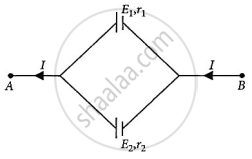Advertisements
Advertisements
प्रश्न
Answer the following question.
Two bulbs are rated (P1, V) and (P2, V). If they are connected (i) in series and (ii) in parallel across a supply V, find the power dissipated in the two combinations in terms of P1 and P2.
उत्तर
Given Bulbs are rated as (P1, V) and (P2, V) respectively
The resistance of 1st bulbs `R_1 = V^2/P_1`
The resistance of 2nd bulbs `R_2 = V^2/P_2`
(i) When both are connected in series with a power supply of voltage V. As both the bulbs are in series connection hence both will have the same amount of current flowing through them.
i = `V/(R_1 + R_2) = V/(V^2/P_1 + V^2/P_2) = 1/V((P_1P_2)/(P_1 + P_2))`
Power dissipated in the circuit
`P_d = i^2(R_1 + R_2) = 1/V^2((P_1P_2)/(P_1 + P_2))^2(V^2/P_1 + V^2/P_2)`
`P_d = (P_1P_2)/(P_1 + P_2)`
(ii) When both are connected in parallel In this case, both bulbs will get the same voltage supply. Hence, power dissipated
`P_d = V^2/R_1 + V^2/R_2 = V^2(P_1/V^2 + P_2/V^2)`
`P_d = P_1 + P_2`.
संबंधित प्रश्न
Calculate force per unit length acting on the wire B due to the current flowing in the wire A.(See
Figure 2 below)

Two metallic wires, P1 and P2 of the same material and same length but different cross-sectional areas, A1 and A2 are joined together and connected to a source of emf. Find the ratio of the drift velocities of free electrons in the two wires when they are connected (i) in series, and (ii) in parallel.
Choose the correct alternative.
Five dry cells each of voltage 1.5 V are connected as shown in the diagram

What is the overall voltage with this arrangement?
Give reason/short answer.
In the given circuit diagram two resistors are connected to a 5V supply.

Calculate potential difference across the 8Ω resistor.
Give reason/short answer.
In the given circuit diagram two resistors are connected to a 5V supply.

A third resistor is now connected in parallel with 6Ω resistor. Will the potential difference across the 8Ω resistor the larger, smaller, or the same as before? Explain the reason for your answer.
Two metal wires of identical dimensions are connected in parallel. If σ1 and σ2 are the conductivities of the metal wires respectively, the effective conductivity of the combination is
If two bulbs of wattages 25 W and 100 W respectively each rated by 220 V are connected in series with the supply of 440 v·then which bulb will fuse?
Two cells of emf’s approximately 5V and 10V are to be accurately compared using a potentiometer of length 400 cm.
First a set of n equal resistors of R each are connected in series to a battery of emf E and internal resistance R. A current I is observed to flow. Then the n resistors are connected in parallel to the same battery. It is observed that the current is increased 10 times. What is ‘n’?
Two cells of emfs E1 and E2 and internal resistances r1 and r2 respectively are connected in parallel as shown in the figure. Deduce the expression for the
- equivalent emf of the combination
- equivalent internal resistance of the combination
- potential difference between the points A and B.

